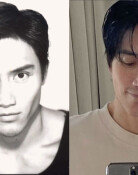Missing alpine pioneer remembered for trailblazing attitude
Missing alpine pioneer remembered for trailblazing attitude
Posted October. 30, 2011 23:15,
"My mountaineering friends Nam Won-woo and Ahn Jin-seop, who came here to overlook with eyes from a higher place and from a higher mountain, were laid to rest in peace here in the Himalayas.¡±
This is a message inscribed by champion alpinist Park Young-seok on a monument he erected en route to Mount Everest (8,850 meters), the world`s highest mountain. He erected the monument after losing two of his junior climbers while scaling the southwest wall of the mountain May 16, 1993.
Park, 47, went missing Oct. 23 with two other climbers while trying to find a new route on the southern side of Mount Annapurna. The search for him and his colleagues has been called off due to safety fears for the rescue team.
He challenged the same route in 2007 and lost two more colleagues, Oh Hee-joon and Lee Hyeon-jo. Coincidentally, the two incidents happened on the same day.
Park did not give up and finally conquered the southwest wall in 2009. He burst into tears and said "Thank you" as he viewed photos of his four late colleagues.
In 2005, he achieved a world first with the "Alpine Grand Slam" by conquering the three "poles" of the earth -- Mount Everest and the two poles -- the 14 highest peaks of at least 8,000 meters in the Himalayas, and the highest mountains in each of the seven continents.
Despite these stellar achievements, he still felt mentally indebted. The southwest wall of Mount Everest had claimed four of his beloved junior colleagues. He climbed up the route while brushing off ruptured muscles on his leg and named the new path the "Korean route."
He wanted to open Korean routes on the 14 highest peaks standing more than 8,000 meters in the Himalayas. This was the biggest unfinished task of his career. He aimed to permanently keep a record of the challenging spirit of Koreans by developing paths in extreme regions that no one had charted before.
¡Û Records and achievements
At age 4, Park climbed the peak of Baekundae on Mount Bukhan in Seoul at age 4, his first conquest of a mountain. He entered Dongguk University, which is famous for its alpinist club, on his second try.
In 1993, he went on to become the first Asian to conquer Mount Everest without oxygen tanks. This was a prelude to his conquering the 14 Himalayan peaks over 8,000 meters, a journey that took eight years and two months to complete. He climbed six of the peaks between 1997 and 1998.
Park thus set a Guinness world record for climbing the most of the Himalayan peaks above 8,000 meters in one year.
By conquering the infamous K2 (8,611 meters) in 2001, he completed all 14 peaks higher than 8,000 meters. He also scaled the highest peaks in the seven continents by conquering Vinson Massif in Antarctica in 2002.
He then visited the South Pole in 2004 and the North Pole in 2005 to achieve the Alpine Grand Slam.
¡Û Injuries and roly poly
In 1991, Park Young-seok suffered a severe injury that exposed his facial bone due to a fall of 100 meters from the southwest wall of Mount Everest. He got the injury stitched without anesthesia.
Five years later, he was swept by an avalanche at the northeast ridge of Mount Everest and plunged 700 meters. Two of his ribs were fractured and his sherpa died.
He also once returned from an expedition by adjusting and fixing his own broken bone.
¡Û Loss of colleagues and mental anguish
Park lost several colleagues in expeditions, but his junior colleagues were always willing to follow him. He was often stubborn but displayed a strong sense of responsibility and leadership like the eldest brother. When he lost two colleagues, he thought about retiring.
They had lived together with him in his rental home for years. After their deaths, he shaved his head, was seen intoxicated every day, and went astray as well as suffering auditory hallucinations. He said, however, ¡°I cannot take rest, and I will live long to make up for their lost lives.¡±
¡Û Reason for mountaineering
When asked why he climbed mountains, Park said,¡°I feel at home on a mountain.¡±
He also talked about the Korean people. Saying he found Korean alpinists always the strongest and most highly spirited on mountains, he said, ¡°Koreans are great people who are undaunted and invincible.¡±
He wanted to demonstrate the high spirit and invincibility of the Korean people, so decided to open Korean routes around the world. His slogan was,¡°If your country has a small territory, compete with the scale of thinking.¡±
¡Û Burden of success, and great culinary skills
He would say, "I`m most afraid of myself." He feared that he would make the wrong decision as chief of his expedition. Members of his expeditionary team, which would receive sponsorships from different supporters, would feel a big burden.
Song Cheol-woong, an outdoor activity expert and a close friend of Park, recalled the mountaineer`s agony, saying ¡°Park often would say it was more difficult to put the sword back than pull it out.¡±
Park always kept in mind this lesson: if he became greedy, it could put everyone at risk.
To succeed as a mountaineer, Park became a master of cooking and developed a specialty of making sushi. For an alpinist, he was like a pro in swimming, fishing and harpooning.
¡Û Money problems and family life
He once sold the gifts he received at his wedding to go mountaineering. He gave his wife his first salary eight years after their marriage. His wife once ran a chicken noodle restaurant.
Park had to withdraw his jeonse (rental home for lump sum key deposit) deposit to go mountaineering.
When he had to pay extra for overweight baggage required for his expedition, he barely passed the flight check-in counter by waiting for hours, saying ¡°I`m a student and have no money.¡±
His favorite song was ¡°I Lived Like a Fool,¡±but his fans and Korea can only wonder if they will hear him sing it again.
The elder of his two sons wants to be a professional golfer.
bluesky@donga.com







